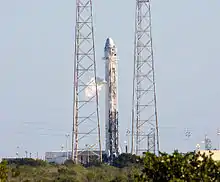Launch vehicle system tests
Launch vehicles often undergo system tests before they are used for spaceflight. A wet dress rehearsal (WDR) and a more extensive static fire are tests of a fully integrated space launch vehicle and its associated ground support equipment (GSE) prior to launch. The spacecraft or payload may or may not be attached to the launch vehicle during the WDR or static fire, but sufficient elements of the rocket and all relevant ground support equipment are in place to help verify that the rocket is ready for flight, with the goal of allowing problems to be seen prior to the actual launch.

Wet dress rehearsal
A wet dress rehearsal is called "wet" because the liquid propellant components (such as liquid oxygen, liquid hydrogen, etc.) are loaded into the rocket during the test. In a pure wet dress rehearsal the rocket engines are not ignited. Wet dress rehearsals may be used on production launch vehicles before each flight of the rocket[1] or on prototype launch vehicles under development.[2]
Static fire
A static fire test includes a wet dress rehearsal and goes one step further: actually firing the engines at full thrust.[2] The engine (or engines) is fired for a few seconds while the launch vehicle, with or without payload attached, is held firmly attached to the launch mount. This tests engine startup while measuring pressure, temperature and propellant-flow gradients. The data gathered in such tests may be used to form a unique (rocket- and engine-specific) set of criteria as part of the go/nogo decision tree in the automated launch software that is used on the actual launch day, typically a few days later. Some static fire tests have fired the engines for up to twelve seconds,[3] although shorter firings are more typical.[4][5]
Use
Many launch service providers do not regularly perform wet dress rehearsals on new launch vehicles; as of 2018 some regularly perform wet dress rehearsals or even full static fire tests on the launch mount. For example, SpaceX typically performs a full static fire on every new booster and also on each reflown booster before every launch, sometimes more than once. In January 2018, SpaceX did two wet dress rehearsals on the Zuma Falcon 9 mission, and conducted multiple wet dress rehearsals on the new Falcon Heavy launch vehicle design which had its maiden launch on 6 February 2018. Both were explicitly booked as wet dress rehearsals, but with the option to proceed to a static fire test. In the event, the second wet dress rehearsal on 24 January 2018 did lead to a full 12-second static fire test of the 27 engines of the Falcon Heavy — a much longer static fire test than the usual 3–7 second duration tests SpaceX uses for the Falcon 9.[6]
Rocket anomalies during launch pad tests
Wet rehearsal and static fire tests can fail catastrophically, as with a pad explosion of a SpaceX Falcon 9 on 1 September 2016,[7] which resulted from a major breach of the cryogenic helium system of the second stage of the rocket during the propellant-loading operations, well before the planned ignition of the engines for a static fire test sequence. The explosion destroyed the rocket and its payload - the Amos-6 satellite. Furthermore, due to extensive fire, the SLC-40 launch pad was heavily damaged and had to be rebuilt.[8][9]
References
- "GPS IIF-2 Wet Dress Rehearsal – SpacePod 2011.06.09". Retrieved 6 July 2011.
- Ralph, Eric (12 May 2020). "SpaceX's first high-flying, triple-Raptor Starship is almost finished". Teslarati. Retrieved 12 May 2020.
- Chris Gebhardt (24 January 2018). "Falcon Heavy comes to life as SpaceX conduct Static Fire test". NASASpaceFlight.com. Retrieved 25 January 2018.
- Chris Gebhardt (12 January 2016). "SpaceX Falcon 9 v1.1 conducts static fire test ahead of Jason-3 mission". NASASpaceFlight.com. Retrieved 12 January 2016.
- "SES-10 F9 static fire – SpaceX for history books & first core stage re-flight – NASASpaceFlight.com". www.nasaspaceflight.com.
- Gebhardt, Chris (2018-01-24). "Falcon Heavy comes to life as SpaceX conduct Static Fire test". NASASpaceFlight.com. Retrieved 2018-01-25.
- Elon Musk: Launch pad explosion is 'most difficult and complex' failure in SpaceX's 14 years LA Times September 9, 2016
- Etherington, Darrell. "SpaceX investigation suggests helium breach caused its Falcon 9 explosion". TechCrunch. Retrieved 2016-09-26.
- Hull, Dana (2016-09-23). "SpaceX Sees Clue to Rocket Blast in Super-Chilled Helium Breach". Bloomberg.com. Retrieved 2016-09-26.
External links
- SpaceX Systems Engineering presentation from CASE 2012, 28 September 2012. Includes description of SpaceX approach to fifth-level hardware-software integration testing during their wet dress rehearsal and/or static fire testing.